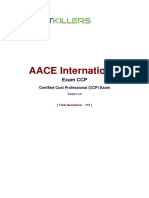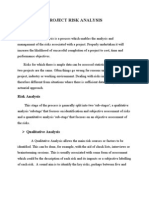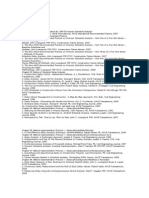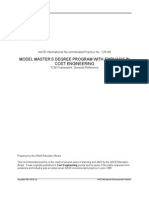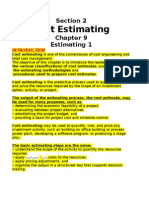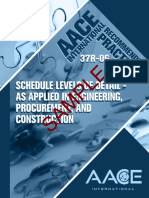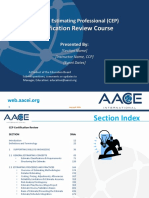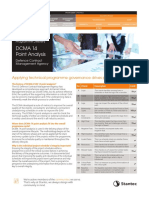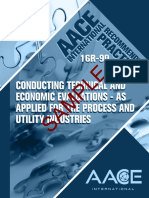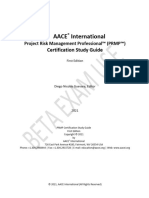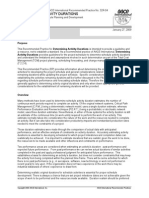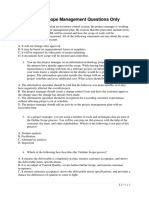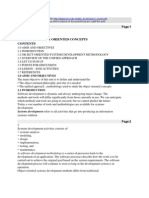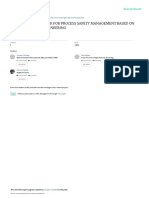Risk Analysis & Contengency
Risk Analysis & Contengency
Uploaded by
manikantanCopyright:
Available Formats
Risk Analysis & Contengency
Risk Analysis & Contengency
Uploaded by
manikantanCopyright
Available Formats
Share this document
Did you find this document useful?
Is this content inappropriate?
Copyright:
Available Formats
Risk Analysis & Contengency
Risk Analysis & Contengency
Uploaded by
manikantanCopyright:
Available Formats
(PUBLIC REVIEW DRAFT) AACE International Recommended Practice No.
42R-08
RISK ANALYSIS AND CONTINGENCY DETERMINATION
USING PARAMETRIC ESTIMATING
TCM Framework: 7.6 Risk Management
August 20, 2008
INTRODUCTION
Scope
This recommended practice (RP) of AACE International (AACE) defines general practices and
considerations for risk analysis and estimating cost contingency using parametric methods. Parametric
methods are commonly associated with estimating cost based on design parameters (e.g., capacity,
weight, etc.); in this case, the method is used to estimate contingency based on risk parameters (e.g.
level of scope definition, process complexity, etc.). This RP includes practices for developing the
parametric methods and models (generally empirically-based). Recommended practice 43R-08 provides
example industry parametric models[12]. For scheduling applications, there is less research and reference
material available; therefore schedule duration risk and contingency will be covered in future revisions of
the RP.
Purpose
This RP is intended to provide guidelines (i.e., not a standard) for contingency estimating that most
practitioners would consider to be good practices that can be relied on and that they would recommend
be considered for use where applicable. There is a range of useful contingency estimating methodologies;
this RP will help guide practitioners in developing or selecting appropriate methods for their situation.
Background
This RP is new. However, it is based on over 40 years of research, development, and practice. The
development and use of parametric risk analysis and contingency estimating methods evolved in parallel
with industrys recognition that poor project scope definition was often the greatest project cost and
schedule risk driver. This recognition led to the development of project scope development processes
(e.g., phase-gate processes) and scope definition maturity matrices such as those included in AACEs
recommended practice for cost estimate classification[1].
Before the above were accepted as best practices, experts first had to prove their value to project
outcomes. They did this by studying actual projects and developing empirically-based parametric models
that showed how poor scope definition resulted in greater cost growth and wider accuracy ranges. A
paper by Hollmann surveys these parametric developments[4] and highlights the pioneering work of the
late John Hackney, followed by Edward Merrow, et al. at the RAND Institute, and Steven Trost, et al. for
the Construction Industry Institute (CII)[5,6,7]. A paper by Baccarini also provides an extensive survey of
these methods[2]. These and the other sources referenced in this RP are recommended reading for
parametric method practitioners.
It is AACEs recommended practice that whenever the term risk is used, that the terms meaning be
clearly defined for the purposes at hand. In expected value practice as described in this RP, risk means
"an undesirable potential outcome and/or its probability of occurrence", i.e. "downside uncertainty (a.k.a.
threats)." Opportunity, on the other hand is "a desirable potential outcome and/or its probability of
occurrence", i.e. "upside uncertainty." The method in this RP quantifies the impact of uncertainty, i.e.
"risks + opportunities".
Background Parametric Estimating
Copyright 2008 AACE International, Inc.
AACE International Recommended Practices
(PUBLIC REVIEW DRAFT) Risk Analysis and Contingency Determination using Parametric Estimating
2 of 8
August 20, 2008
This is not an RP on parametric estimating, but a basic understanding of it is required. AACEs Cost
Engineering Terminology defines a parametric estimate as one that has estimating algorithms or cost
estimating relationships that are highly probabilistic in nature [8]. Generally, the relationships of the
outcome (e.g., cost growth) and the inputs (e.g., risk drivers) are determined by studying empirical data
using methods such as multi-variable regression analysis, neural networks, or even trial and error. The
following illustrates the typical form of a simple parametric estimating algorithm:
Outcome = Constant + Coefficient 1*(Parameter A) + Coefficient 2*(Parameter B) +..
The outcome in this case may be a measure of cost growth (e.g., contingency percent), and the
parameters are various quantified risk drivers such as a measure of the level of scope definition upon
which the estimate or schedule was based. The algorithm can be much more complex employing
logarithmic, exponential, and power series.
Advantages of parametric estimating for risk analysis and contingency determination are that it is
inherently empirical in nature (based on actual measured experience) and it can directly provide
probabilistic information about the distribution of possible outcomes. It is also very quick and simple to
apply.
A disadvantage is that parametric estimating is based on empirical methods such as regression analysis
and these require that the parameters actually have more or less predictable relationships with the
outcomes. This is more true for some risk types than for others. Another disadvantage is that obtaining
empirical data and creating models is a challenging effort; increasingly so as one attempts to model cost
growth and risk drivers at more detail levels. Therefore, the method is typically limited in use to estimating
overall project contingency that results from select risk types. As will be explained in the next section, this
is not a problem for early estimates (i.e., AACE Class 5), but for later estimates (i.e., Class 4 or better) the
method is best used in combination with range estimating, event tree analysis or other more definitive
methods.
Background Risk Types
In respect to parametric methods, risk types fall into one of two categories; risks that have systematically
predictable relationships to overall project cost growth outcome and those that dont. These categories
have been labeled as systemic and project-specific risks for contingency estimating purposes (i.e.,
there will be other ways to categorize risk types for other purposes.) [4]. To use the methods properly, it is
important to understand the distinctions of these types.
The term systemic implies that the risk is an artifact of the project system, culture, business strategy,
process system complexity, technology, and so on. Research by Hackney and others has shown that the
impacts of some of these risks are measurable and predictable between projects within a system, and to
some extent within an industry as a whole. Measures of these risks are generally known even at the
earliest stages of project definition, and furthermore, the impacts of these risks tend to be highly dominant
for early estimates. Also, the link between systemic risks and cost impacts is stochastic in nature; this
means it is very difficult for individuals or teams to understand and to directly estimate the impact of these
risks on particular items or activities (for example, the risks of process technology on something like site
preparation or concrete foundations may be dramatic, but is not readily apparent). Finally, systemic risks
tend to be owner risks; i.e., the owner is responsible for early definition, planning, technology, and
decisions so these risks cannot be readily transferred to execution contractors. The following are typical
systemic risks dealt with using parametric methods:
Process Definition
Basic Design
Level of Technology
Copyright 2008 AACE International, Inc.
AACE International Recommended Practices
(PUBLIC REVIEW DRAFT) Risk Analysis and Contingency Determination using Parametric Estimating
3 of 8
August 20, 2008
Process Complexity
Material Impurities
Project Definition
Site/Soils Requirements
Engineering and Design
Health, Safety, Security, Environmental
Planning and Schedule Development
Project Management and Estimating Process
Estimate Inclusiveness
Team Experience/Competency
Cost Information Available
Estimate Bias
When estimate bias is psychological or political in nature, it is particularly difficult to measure and quantify
because it deals with deception, intentional or unintentional. To assess the impact of these types of risks
(i.e., optimism bias and strategic misrepresentation), a methodology called reference class forecasting
(not covered here), a form of estimate validation, has been proposed by Flyvbjerg [3]. Whether and how
these systemic psychological and political risks can be better measured, and incorporated in parametric
techniques is an area of active research, particularly for infrastructure mega-projects. In any case,
estimate validation (to detect bias among other objectives) is always a recommended practice in
conjunction with risk analysis.
The term project-specific implies that the risk is, as it says, specific to the project. The impacts of these
risks are not highly predictable between projects within a system or within an industry as a whole. For
example, rain may have much more impact on one project than another depending on the project
characteristics and circumstances. Measures of these risks are generally not known at the earliest stages
of project definition (e.g., for Class 5 estimates, rain cannot be considered because the location of a
project, the season of its construction, and other circumstances may not be known). Also, the link
between project-specific risks and cost impacts is more deterministic in nature; i.e., they are amenable to
individual understanding and to estimating the impact of these risks on particular items or activities (for
example, the risks of excess rain on something like site preparation or concrete foundations can be
estimated). Finally, these types of risks are more negotiable during project contracting strategy as to who
will carry them. The following are typical project-specific risks (this list is far from inclusive):
Weather
Site Subsurface Conditions
Delivery Delays
Constructability
Resource Availability
Project Team Issues
Quality Issues (e.g., rework)
Etc.
This breakdown of risk types indicates why a combination of risk analysis and contingency estimating
methods should be used for optimal understanding and quantification of risks of different types. The RP
will explain how multiple contingency estimating methods can be used and their results combined. For
Class 5, parametric methods can be used alone given the knowledge of the systemic risk factors (and
lack of knowledge of project specifics) and the dominance of their impacts at this phase. Project-specific
risks become more dominant as scope is better defined (and hence some systemic risks are mitigated),
but there are always systemic risks that should be analyzed as thoroughly as practical.
Copyright 2008 AACE International, Inc.
AACE International Recommended Practices
(PUBLIC REVIEW DRAFT) Risk Analysis and Contingency Determination using Parametric Estimating
4 of 8
August 20, 2008
RECOMMENDED PRACTICE
Practices for parametric risk analysis and contingency estimating methods necessarily focus on
development of the parametric model(s) because that is the most challenging aspect; use of parametric
models is relatively simple.
Model Development
Processes Come First
Prior to developing and using any risk analysis or contingency estimating practice, the enterprises risk
management process should be developed in alignment with the appropriate overall asset management
and project control processes, which in turn should align with business strategy. Process maps show
inputs and outputs of a method which help identify stakeholders in its practice. Example processes are
covered in AACEs Total Cost Management (TCM) Framework[9]. In particular, if the company has no
formal project scope development process, or process or system for project historical database or
knowledge management, empirically-based parametric methods will be difficult to develop or maintain
(however, implementing parametric methods can put emphasis on the companys need to strengthen
these processes).
Determine Requirements
Company processes and stakeholder input will help establish requirements of the scope of the method
and scope of the effort to develop, maintain, and use it. Some typical requirements (and constraints) to
consider include:
Classes of estimates: If your company is a contractor that only deals with Class 3 or better estimates,
and most systemic risks are carried by the owner, parametric methods offer less value. However, for
owners developing Class 5 estimates, parametric methods are extremely valuable.
Types of projects and risks: If you estimate and fund projects using new technology, complex
processes, complex strategies, and so on, parametric methods increase in value and you will want to
be sure to identify and analyze these types of risks (in addition to the level of scope definition).
Corporate risk management strategies: If you are responsible for analyzing not only cost and
schedule risks, but also technical, health and safety or other kinds of risks, this may affect the
development process (this RP addresses cost risks)
Resources and competencies available: because of the reliance on empirical data analysis, the
development of models requires significant resources with special analysis skills (particularly
statistical). On the other hand, because the methods are very simple to apply, and because they
inherently incorporate empirical learnings, they can be used by project teams with less expert help
than other methods.
Historical Data
Having identified requirements in terms of the types of projects and risks to be addressed, the
requirements for historical or empirical data can be defined. The list of systemic risks provided previously
is a starting point; developers should study the references to this RP for more information on the specific
risk drivers to measure and capture. The primary risks are the level of scope definition, the level of new
technology in the process, and the complexity of the process and the project strategy. How to measure
and record these risks quantitatively must then be determined.
Having identified the risks (i.e., parameters of the model), measures of the outcome must be determined.
In general these include cost growth relative to the base estimate excluding contingency.
Copyright 2008 AACE International, Inc.
AACE International Recommended Practices
(PUBLIC REVIEW DRAFT) Risk Analysis and Contingency Determination using Parametric Estimating
5 of 8
August 20, 2008
One systemic risk that is a challenge to measure is the competitiveness and quality of the base estimate.
Fat base estimates (i.e., hidden contingency above-the-line) may result in little need for or usage of
additional contingency. Therefore, a process to review and validate the competitiveness and quality of the
base estimate becomes an ancillary part of the risk management process.
Having determined the parameters and outcomes to capture, data collection and management
procedures need to be established. Ideally, these will be part of your project historical database
management process, including project close-out processes.
Reference and External Information
As mentioned, the references to this RP should be studied. The Hackney and Merrow references include
models that have been developed from industry data, and are still generally applicable. AACE has
documented these models in RP 43R-08. These models can serve as a starting point or go-bys for
internal developments. Other external data on risks and their outcomes from benchmarking sources and
other literature [e.g., AACEs technical library and Professional Practice Guides (PPGs)] should be
obtained.
Data Analysis and Tool Development
Having collected project risk and outcome data including quantitative measures for modeling, it must be
cleaned to ensure that the sample to be used for model building or evaluation is free of significant error
and is representative (i.e., no extreme outliers that tend to bias analyses). Outcome data must also be
normalized for (i.e., corrected for) escalation, currency, and scope change impacts which are not covered
by contingency.
Two methods of parametric model building are commonly found in the literature. The most traditional and
widely used is multi-variable linear regression analysis. Standard spreadsheet software generally has this
analytical capability. The other more recent method is neural network analysis. This requires special
software. The model building methods used for risk analysis and contingency estimating tools are the
same as those used for general estimating models; the only difference is in the nature of the parameters
and outputs.
Regression analysis will typically find some sort of relationship between one of more of the parameters
and the outcome measure. However, the relationship must be tested and challenged to ensure that it is
statistically significant (e.g., using t or F statistics), that it is causal in nature (i.e., there should be a
rational hypothesis for why a parameter is impacting the outcome to the extent noted), that the variables
are independent and not co-linear, and that the model is not overly biased by outlier data points, and so
on.
Once a valid model is obtained, it is usually implemented in a spreadsheet tool wherein the user enters
the parameter values and the model generates the predicted contingency value, usually as a percentage
of the base estimate value. The regression output represents the mean contingency which for normally
distributed data is equivalent to the p50 value (50 percent of the time the result will be over or under this
value).
After a base model is built, analysts can supplement the base model constants, coefficients, and
parameters with various logical assumptions and adjustments that may not have been included in the
analytical dataset[10]. For example, if database included a set of projects for which project definition was
rated on a scale of 5 to 1 using AACEs scope development maturity matrix (i.e., from RP 18R-97), and
later, AACE adds a new risk-driving deliverable to the maturity matrix, the analyst may have to make
manual adjustments to their model as appropriate to address how the change may affect the 5 to 1 rating.
Probabilistic Outcomes
The base model generates the mean or p50 result value. However, best practice for risk analysis and
contingency estimating is to produce a distribution of possible outcomes so that management can decide
how much risk they are willing to accept and therefore how much contingency will be required. The
Copyright 2008 AACE International, Inc.
AACE International Recommended Practices
(PUBLIC REVIEW DRAFT) Risk Analysis and Contingency Determination using Parametric Estimating
6 of 8
August 20, 2008
regression analysis will provide some evidence of the probability distribution. In particular, it provides the
standard error of the estimate for the regression model dataset. However, the regression dataset may be
limited in scope, and cannot always be relied on to fully represent the range of possible outcomes.
There is a simple method, which is consistent with observed industry data (including AACEs RP 18R-97),
to generate a reasonably reliable probability distribution for cost contingency. That method is to assume
that cost outcomes (after allowing for contingency) are more-or-less normally distributed and to further
assume that contingency is equal to the standard deviation of the distribution [11]. With these assumptions,
the normal cumulative distribution can be computed using the NORMINV function in Excel [syntax is
NORMINV(probability, mean, std. dev)]. The following is an example of such a distribution.
Given:
Base Estimate (without contingency)
Contingency from the parametric model
Total Cost (at p50) = $100 + $20
=
=
=
$100
$20
$120
Then the Cumulative Probability Distribution is:
p
10%
20%
30%
40%
50%
60%
70%
80%
90%
Total$
NORMINV (probability,120,20)
$ 94
$ 103
$ 110
$ 115
$ 120
$ 125
$ 130
$ 137
$ 146
Contingency$
(Total-Base)
$ (6)
$3
$ 10
$ 15
$ 20
$ 25
$ 30
$ 37
$ 46
These results can be reported in the tool in tables or charts as desired.
Dealing With a Lack of Company-Specific Historical Data
Unfortunately, good project data is difficult to collect and analyze. Fortunately, systemic risks and their
impacts for industry projects have been fairly consistent with time. Therefore, lacking any other method,
the parametric models from Hackney and Merrow can be used with some confidence after validating
against your own experience. The models have been included in working versions in recommended
practice 43R-08.
Risk Analysis and Model Use
Identify and Quantify Systemic Risks
Because the parametric model has pre-determined risks (i.e., the parameters), the risk analysis is
simplified. While this is not an RP on how to conduct a risk analysis session or workshop, the typical
practice is to hold a meeting of the key team members and other project stakeholders, and to start with
identifying risks. In this case, the risk types are identified, so the team concentrates on quantifying the
parameters; e.g., rating the level of definition of each key deliverable in the project scope maturity matrix,
rating the level of new technology, and so on.
The more difficult challenges are agreeing on subjective systemic risk drivers such as the quality of the
base estimating data and the project teams competency. Because these types of risks are in fact
Copyright 2008 AACE International, Inc.
AACE International Recommended Practices
(PUBLIC REVIEW DRAFT) Risk Analysis and Contingency Determination using Parametric Estimating
7 of 8
August 20, 2008
systemic (i.e., an artifact of the companys culture and capabilities that the project cannot do much
about), it is recommended that default ratings be set for these to avoid over-optimism. The ratings can be
changed, but the team must provide specific reasons why this project bucks-the-system.
Estimating Contingency
Once the parameters are quantified, the contingency and probability distribution for systemic risks are
estimated by simply plugging the parameter values in the model. The user should make quality checks
and validate that the results are reasonable before reporting them to management.
Coordinate with Contingency Estimates for Project-Specific Risks
For Class 5 estimates, parametric methods alone are generally adequate, given the dominance of
systemic risk impacts and lack of knowledge of project specifics. For Class 4 or better, other methods
such as range estimating or event tree analysis should be used in combination with the parametric
analysis. These methods are covered in other RPs.
The most important consideration in combining methods and outcomes is to ensure that risks are not
double counted. After risks are identified in a risk analysis session, each risk must be categorized as
systemic or project-specific. Each risk is then quantified in their respective analyses and contingency
estimates.
Parametric and event tree analysis can be easily combined because event tree (i.e., expected value)
models work by directly estimating the probable cost distribution of the impacts of each risk. In that case,
the results of the parametric model (including its probability distribution) are included in the event tree
analysis as the first risk. Then other project-specific risks (e.g., heavy rain) are quantified and added to
the model. Monte-Carlo simulation can then be applied to the entire combined cost risk model to obtain a
combined probability distribution.
If range estimating is used for project-specific risk analysis, the combination cannot be done through a
combined Monte Carlo simulation to obtain an overall cost outcome distribution. This is because range
estimating does not model the cost impacts of each risk, but the cost range (resulting from many risks) of
critical items in the estimate. Another challenge is that range estimating recommends that the team
consider the extremes for the minimum and maximum cost of critical items and it is difficult, if not
impossible, to parse the impact of any particular risk. For these reasons, it is not the preferred
combination of methods. However, if care is take in not double counting the impact of system and projectspecific risks, the cost values at the various levels of probability can be added for these two methods.
Summary
It is hoped that enough information was provided in this RP to help guide practitioners in developing or
selecting appropriate methods for their situation. Users are encouraged to study the reference materials
provided with this RP. Future revisions of the RP are expected to cover scheduling applications.
REFERENCES
1. AACE International, Recommended Practice No. 18R-97, Cost Estimate Classification SystemAs
Applied in Engineering, Procurement, and Construction for the Process Industries, AACE
International, Morgantown, WV, (latest revision).
2. Baccarini, David, The Maturing Concept of Estimating Project Cost Contingency - A Review, 31st
Australasian University Building Educators Association Conference (AUBEA 2006): July, 2006
(http://espace.lis.curtin.edu.au/).
3. Flyvbjerg, B., From Nobel Prize to Project Management: Getting Risks Right, Project Management
Journal, August 2006.
Copyright 2008 AACE International, Inc.
AACE International Recommended Practices
(PUBLIC REVIEW DRAFT) Risk Analysis and Contingency Determination using Parametric Estimating
8 of 8
August 20, 2008
4. Hollmann, John K., The Monte-Carlo Challenge: A Better Approach, AACE International Transactions,
AACE International, Morgantown, WV, 2007.
5. Hackney, John W. (Kenneth H. Humphreys, Editor), Control and Management of Capital Projects,
2nd Edition, AACE International, 1997.
6. Merrow, Edward W., Kenneth E. Phillips, and Christopher W. Meyers, Understanding Cost Growth
and Performance Shortfalls in Pioneer Process Plants, (R-2569-DOE), RAND Corporation, 1981.
7. Trost, Steven M. and Garold D. Oberlender, Predicting Accuracy of Early Cost Estimates Using
Factor Analysis and Multivariate Regression, Journal of Construction Engineering and Management,
Volume 129, Issue 2, pp. 198-204 (March/April 2003)
8. AACE International, Recommended Practice No. 10S-90, Cost Engineering Terminology, AACE
International, Morgantown, WV, (latest revision).
9. Hollmann, John K., Editor, Total Cost Management Framework: An Integrated Approach to Portfolio,
Program, and Project Management, (Chapter 7.6 Risk Management), AACE International,
Morgantown WV, 2006.
10. Whiteside, J.D., Contingency Modifier Tool, AACE International Transactions, AACE International,
Morgantown, WV, 2007.
11. Rothwell, Dr. Geoffrey, Cost Contingency as the Standard Deviation of the Cost Estimate, Cost
Engineering, AACE international, Morgantown, WV, July 2005.
12. AACE International Recommended Practice No. 43R-08, Risk Analysis and Contingency
Determination Using Parametric Estimating Example Models As Applied for the Process Industries,
AACE International, Morgantown, WV, (currently under review).
CONTRIBUTORS
John K. Hollmann, PE CCE CEP (Author)
Robert F. Wells, CEP
Copyright 2008 AACE International, Inc.
AACE International Recommended Practices
You might also like
- Schedule Levels of Detail - As Applied in Engineering, Procurement and ConstructionDocument3 pagesSchedule Levels of Detail - As Applied in Engineering, Procurement and ConstructionRommel Jay Galvez50% (2)
- 30R-03 Implementing Project ConstructionDocument9 pages30R-03 Implementing Project Constructionmaifi100% (2)
- 031 42r-08 Risk Analysis and Contingency Determination Using Prametric EstimatingDocument18 pages031 42r-08 Risk Analysis and Contingency Determination Using Prametric EstimatingJuan Carlos Piñeiro100% (1)
- 44R-08 Risk Analysis and Contingency Determination Using Expected ValueDocument8 pages44R-08 Risk Analysis and Contingency Determination Using Expected ValueDody BdgNo ratings yet
- The Users Guide To Acumen FuseDocument2 pagesThe Users Guide To Acumen FuseKatie BensonNo ratings yet
- 71R-12 Aace PDFDocument43 pages71R-12 Aace PDFmirakulNo ratings yet
- 10S-90 - 2014-Cost Engineering Terminology PDFDocument120 pages10S-90 - 2014-Cost Engineering Terminology PDFHohnWu100% (1)
- CCP-Sample Paper-CertKilllersDocument3 pagesCCP-Sample Paper-CertKilllersimalinaqviNo ratings yet
- EST.2833 Maturity Assessment For Engineering DeliverablesDocument24 pagesEST.2833 Maturity Assessment For Engineering DeliverablesSidney Porter100% (1)
- 42R-08 Risk Analysis and Contingency Determination Using Parametric EstimatingDocument9 pages42R-08 Risk Analysis and Contingency Determination Using Parametric EstimatingDody BdgNo ratings yet
- 57R-09 Aace PDFDocument24 pages57R-09 Aace PDFmirakulNo ratings yet
- 18R 97Document16 pages18R 97Jorge VelasquezNo ratings yet
- Schedule Risk Analysis v1Document13 pagesSchedule Risk Analysis v1ita1270% (1)
- John K. Hollmann, PE CCE: 2002 AACE International TransactionsDocument7 pagesJohn K. Hollmann, PE CCE: 2002 AACE International Transactionslalouni100% (1)
- Project Risk AnalysisDocument6 pagesProject Risk AnalysissundivanaNo ratings yet
- Rule of ThumbDocument1 pageRule of ThumbWendy CowartNo ratings yet
- Master Test Plan: Macy's Loyalty ProgramDocument21 pagesMaster Test Plan: Macy's Loyalty Programvizag_vinodNo ratings yet
- AA - SPEC - 114005 - Flooring, Stairs, Ladders & HandrailsDocument45 pagesAA - SPEC - 114005 - Flooring, Stairs, Ladders & HandrailsJakesNo ratings yet
- Software Process QualityDocument258 pagesSoftware Process QualitySatish Marri100% (1)
- Sample SRS DocumentDocument13 pagesSample SRS DocumentAbhishek VisputeNo ratings yet
- AACE 92r-17Document4 pagesAACE 92r-17umerNo ratings yet
- PERT Master - Risk Analysis ToolDocument22 pagesPERT Master - Risk Analysis ToolPallav Paban BaruahNo ratings yet
- Toc - 41r-08 - Range Risk AnalysisDocument4 pagesToc - 41r-08 - Range Risk AnalysisdeeptiNo ratings yet
- ..AACE InternationalDocument3 pages..AACE International891966No ratings yet
- Chapter 10 PDFDocument30 pagesChapter 10 PDFPandaNo ratings yet
- Project Schedule Risk AnalysisDocument10 pagesProject Schedule Risk Analysisturusan94256100% (2)
- RI SK Analysi S AND Conti Ngency Determi Nati ON USI NG Expected ValueDocument10 pagesRI SK Analysi S AND Conti Ngency Determi Nati ON USI NG Expected ValueLila ToteNo ratings yet
- Monte Carlo Analysis Used For Contingency EstimatingDocument15 pagesMonte Carlo Analysis Used For Contingency EstimatingAdriana EscobarNo ratings yet
- 12R-89 - Master in Cost EngeneeringDocument8 pages12R-89 - Master in Cost Engeneeringstefan_iacob72No ratings yet
- Integrated Cost and Risk Analysis Using Monte Carlo Simulation of A CPM ModelDocument4 pagesIntegrated Cost and Risk Analysis Using Monte Carlo Simulation of A CPM ModelPavlos Vardoulakis0% (1)
- Hollmann Alternate MethodsDocument11 pagesHollmann Alternate MethodsdeeptiNo ratings yet
- The Art and Science Behind Successful Risk WorkshopsDocument10 pagesThe Art and Science Behind Successful Risk WorkshopsAcumenNo ratings yet
- Hussam Estimation1Document19 pagesHussam Estimation1Abdo England100% (1)
- Risk AnalysisDocument43 pagesRisk AnalysisSailesh NgangbamNo ratings yet
- Toc Ppg16-E2 PDFDocument9 pagesToc Ppg16-E2 PDFdanudmwNo ratings yet
- Integrated Cost and Scheduled Project Risk AnalysisDocument11 pagesIntegrated Cost and Scheduled Project Risk Analysisapi-27145250No ratings yet
- Monte Carlo SimDocument29 pagesMonte Carlo SimAbhiyan Anala Arvind100% (1)
- Risk Attitude and Risk Controllability: Their Implications On The Subjective Quantification of Risk in International Construction ProjectsDocument13 pagesRisk Attitude and Risk Controllability: Their Implications On The Subjective Quantification of Risk in International Construction ProjectsIJAERS JOURNALNo ratings yet
- Cost Estimating: White PaperDocument5 pagesCost Estimating: White PaperJoeNo ratings yet
- Toc Ppg01-E4 PDFDocument29 pagesToc Ppg01-E4 PDFdanudmwNo ratings yet
- Integrated Cost - Schedule Risk AnalysisDocument7 pagesIntegrated Cost - Schedule Risk AnalysisrezadNo ratings yet
- 18R 97Document16 pages18R 97Loreto Urra0% (1)
- Aace SampleDocument4 pagesAace SampleAjaya KumarNo ratings yet
- Cost Estimate Classification System - As Applied in Engineering, Procurement, and Construction For The Process IndustriesDocument6 pagesCost Estimate Classification System - As Applied in Engineering, Procurement, and Construction For The Process IndustriesloginxscribdNo ratings yet
- Risk ManagementDocument41 pagesRisk ManagementkhoiNo ratings yet
- Cepsiab Sample For Web 2021Document37 pagesCepsiab Sample For Web 2021CCENo ratings yet
- Benchmarking Project SchedulesDocument17 pagesBenchmarking Project SchedulesSidra AhsanNo ratings yet
- RISK.03 Integrated Cost and Schedule Risk AnalysisDocument34 pagesRISK.03 Integrated Cost and Schedule Risk AnalysisWaheed ElbeihNo ratings yet
- Toc 18R-97Document6 pagesToc 18R-97gian93100% (1)
- AACEI RecommendedPractice No.15R-81Document11 pagesAACEI RecommendedPractice No.15R-81Anonymous 19hUyemNo ratings yet
- Earned Schedule PDFDocument59 pagesEarned Schedule PDFJuan Lemos100% (1)
- Uk Dcam 14 Point Analysis BrochureDocument2 pagesUk Dcam 14 Point Analysis BrochureAbdullahNo ratings yet
- Risk Analysis of Project Time and Cost Through Monte Carlo MethodDocument68 pagesRisk Analysis of Project Time and Cost Through Monte Carlo MethoddeeptiNo ratings yet
- A Risk and Cost ManagementDocument8 pagesA Risk and Cost ManagementRoberto CastroNo ratings yet
- Toc 16r-90Document11 pagesToc 16r-90jorgemarcont superNo ratings yet
- Aace International: Certification Study GuideDocument8 pagesAace International: Certification Study GuideEdgar OblitasNo ratings yet
- Project Portfolio ManagementDocument114 pagesProject Portfolio ManagementdipanajnNo ratings yet
- Ce03 12Document48 pagesCe03 12BTconcordNo ratings yet
- Quantitative Risk Assessment A Complete Guide - 2020 EditionFrom EverandQuantitative Risk Assessment A Complete Guide - 2020 EditionNo ratings yet
- Selection of Technical Risk Responses For Efficient Contingencies Edouard Kujawski, PH.DDocument26 pagesSelection of Technical Risk Responses For Efficient Contingencies Edouard Kujawski, PH.DJosh SabimanNo ratings yet
- Project Risk Simulation Methods - A Comparative Analysis: Abstract. Effective Risk ManagementDocument16 pagesProject Risk Simulation Methods - A Comparative Analysis: Abstract. Effective Risk ManagementSimon WerNo ratings yet
- Models: "Quad II Diaphragm" 4125 Series Bilge PumpDocument4 pagesModels: "Quad II Diaphragm" 4125 Series Bilge PumpmanikantanNo ratings yet
- Rubber Support Insert: Product FeaturesDocument2 pagesRubber Support Insert: Product FeaturesmanikantanNo ratings yet
- 16 15C7 FiltersDocument5 pages16 15C7 FiltersmanikantanNo ratings yet
- Construction MethodologyDocument9 pagesConstruction MethodologymanikantanNo ratings yet
- Recovery ScheduleDocument15 pagesRecovery SchedulemanikantanNo ratings yet
- Determining Activity Durations: PurposeDocument12 pagesDetermining Activity Durations: PurposemanikantanNo ratings yet
- Scheduling Claims ProtectionDocument9 pagesScheduling Claims ProtectionmanikantanNo ratings yet
- Schedule Level of DetailsDocument7 pagesSchedule Level of DetailsmanikantanNo ratings yet
- Analysing S CurvesDocument9 pagesAnalysing S CurvesmanikantanNo ratings yet
- Schedule ConstructibilityDocument9 pagesSchedule ConstructibilitymanikantanNo ratings yet
- Rehab8 1 HvacDocument43 pagesRehab8 1 Hvacapi-3859258100% (2)
- HVAC Ducts and CasingsDocument10 pagesHVAC Ducts and CasingsmanikantanNo ratings yet
- Software Testing TechniquesDocument191 pagesSoftware Testing TechniquesAnant MoreNo ratings yet
- Satellite UmlDocument6 pagesSatellite UmlPrasanna R ChandranNo ratings yet
- Requirements Validation Checklist: (Document Subtitle)Document4 pagesRequirements Validation Checklist: (Document Subtitle)WeyNo ratings yet
- Ba ExtensionDocument2 pagesBa Extensionraj xiliniveNo ratings yet
- Chapter - 1 - Intro To Software Project ManagementDocument26 pagesChapter - 1 - Intro To Software Project ManagementVasudevan Sundararaman100% (1)
- A Rational Design Process: How and To Fake ItDocument7 pagesA Rational Design Process: How and To Fake ItJhoel LithusNo ratings yet
- 2.1 Scope Management Questions OnlyDocument30 pages2.1 Scope Management Questions OnlyKobby Owusu100% (1)
- UML复习Document14 pagesUML复习xinrui.zhang77No ratings yet
- Mb0047 Unit 05-SlmDocument24 pagesMb0047 Unit 05-SlmBibin JoyNo ratings yet
- RKPL 2019 - Introduction To SE (Pert. 2)Document37 pagesRKPL 2019 - Introduction To SE (Pert. 2)Kemas RayfaldoNo ratings yet
- 01 - The Design Process - NASA PDFDocument42 pages01 - The Design Process - NASA PDFrafael ricardo molina navarroNo ratings yet
- Senior QA Automation EngineerDocument3 pagesSenior QA Automation EngineerMihaela AvramNo ratings yet
- Case StudyDocument26 pagesCase StudyRoman Anthony AgdonNo ratings yet
- Operation Unit 1Document38 pagesOperation Unit 1Se SathyaNo ratings yet
- Reqview Software Requirements Specification Example: Project: DemoDocument13 pagesReqview Software Requirements Specification Example: Project: DemoPriyaNo ratings yet
- Module 2 PDFDocument32 pagesModule 2 PDFalbinoNo ratings yet
- OoadDocument169 pagesOoad5zuNo ratings yet
- Successful State Safety Programme (SSP)Document10 pagesSuccessful State Safety Programme (SSP)Edgar ChávezNo ratings yet
- Srs Template 1Document8 pagesSrs Template 1Majid KhanNo ratings yet
- Naresh Prajapati (Roll No: 517) Jaydeep Patel (Roll No: 562) Semester - ViDocument38 pagesNaresh Prajapati (Roll No: 517) Jaydeep Patel (Roll No: 562) Semester - ViM.Basit RahimNo ratings yet
- Practical Framework For Process Safety ManagementDocument13 pagesPractical Framework For Process Safety ManagementSubhi El Haj Saleh100% (1)
- PBL 2.oDocument40 pagesPBL 2.oFE-B-247 DIPESH KUMAR YADAVNo ratings yet
- Literature Automotive-Spice PocketguideDocument67 pagesLiterature Automotive-Spice PocketguideDiana Ardelean-BugariuNo ratings yet
- Software Requirement Specification - Tariq KhanDocument18 pagesSoftware Requirement Specification - Tariq Khansun.developer72270% (1)
- DbmsDocument99 pagesDbmspalaniperumal041979No ratings yet
- Ams - SRSDocument16 pagesAms - SRSNino Joshua CastinoNo ratings yet







